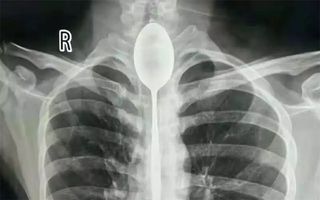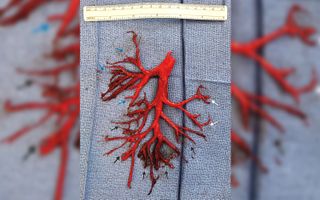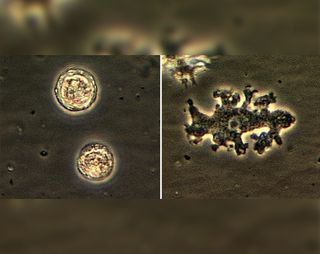10 Strangest Medical Cases of 2018
Odd medicine

From a man who coughed up a lung-shaped blood clot to a woman with parasites in her spine, a number of intriguing medical cases made headlines in 2018.
So-called "case reports," which describe the conditions of individual patients, don't carry the same authoritative weight as rigorous scientific studies with hundreds or thousands of people participating. But such reports can sometimes help doctors better understand rare diseases or spot unusual signs of common conditions.
Here are 10 of the strangest case reports Live Science covered in 2018.
Man coughs up giant lung-shaped blood clot

A man in California didn't literally cough up his lung, but he came pretty close. The 36-year-old patient shocked his doctors when he coughed up a giant blood clot in the shape of his lung. How could this happen? The man was being treated for a serious heart condition that required him to take a blood-thinning medication. But this medication also increased his risk of bleeding.
During an "extreme bout of coughing," the patient expelled an "intact cast" of the right bronchial tree. In other words, it was a mold (cast) made of clotted blood in the shape of the lung's branched airway passages known as bronchi. It's very rare to see this type of "cast" made of blood, his doctors said. The man's condition was so severe, he died a week later due to complications. His doctors decided to publish the image to show the "beautiful anatomy of the human body."
A report of the case was published Nov. 29 in The New England Journal of Medicine.
Woman's 'brain-eating' amoeba infection tied to her neti pot

A woman in Seattle developed a rare and fatal "brain-eating" amoeba infection, which may have been due to improper use of a neti pot. The 69-year-old woman had been using a neti pot to rinse her sinuses, but filled it with nonsterile tap water instead of the recommended sterile water or saline solution. Soon, she developed a small rash on her nose that wouldn't go away. Then, a year later, she had a seizure.
At first, doctors thought she had a brain tumor, but tests showed she was infected with an amoeba called Balamuthia mandrillaris. These infections are very rare, with about 70 cases reported in the U.S. since 1993. Doctors suspect the woman got the infection from the unsterilized tap water, which is why it's important for those who try a neti pot to use sterile water or saline.
The case was published in the December issue of the International Journal of Infectious Diseases.
Man had a spoon stuck in his esophagus for a year

A spoonful of sugar may help the medicine go down, but nothing helps the spoon go down. A man in China found this out the hard way when he swallowed a spoon on a dare. The utensil got stuck in his esophagus, but surprisingly, it didn't cause him much discomfort. It wasn't until about a year later when, after being punched in the chest, he began experiencing chest pains and having difficulty breathing, which prompted him to seek medical care. Doctors performed a two-hour procedure to remove the spoon, according to a statement from Xinjiang Meikuang General Hospital, where the patient was treated in October. Doctors expected the man to make a quick recovery.
Eating squirrel brains tied to rare brain infection

A man in New York developed an extremely rare and fatal brain disorder after he ate squirrel brains. The 61-year-old man was taken to a hospital after experiencing a decline in his thinking abilities and losing touch with reality. His family said he liked to hunt, and it was reported that he had eaten squirrel brains. This strange dietary habit may have put him at risk for variant Creutzfeldt-Jakob disease (vCJD), a fatal brain condition caused by infectious proteins called prions. Indeed, an MRI scan of the man's head appeared similar to scans of people who have vCJD. Doctors said the man likely had vCJD, although the diagnosis has not been officially confirmed with an autopsy.
Only a few hundred cases of vCJD have ever been reported, and most were tied to consumption of contaminated beef in the United Kingdom in the 1980s and 1990s.
The man's case occurred in 2015 but was reported for the first time in October 2018 at a scientific meeting on infectious diseases.
A 'lost' contact lens shows up 28 years later

When a woman in the United Kingdom lost her contact lens while playing badminton, she didn't think much of it. But nearly three decades later, doctors found the contact lens embedded in her eyelid.
The 42-year-old woman went to the eye doctor after her left eyelid became swollen and started to droop. Tests revealed she had a cyst in her eyelid, which was surgically removed. But inside the cyst was the missing contact lens. The woman had lost the lens when she was 14 years old, after she was hit in the eye with a shuttlecock during a badminton game. It appears that the trauma caused the lens to migrate into her left eyelid, her doctors said.
A report of the woman's case was published Aug. 10 in the journal BMJ Case Reports.
Garlic doesn't treat foot fungus. But it does cause burns.

When a woman in England developed a fungal infection on her toenail and big toe, she decided to try a home remedy: garlic. But the garlic treatment not only didn't work, it caused severe burns on her skin. The woman had applied slices of raw garlic to her toe for up to 4 hours a day for a month, according to a report of the case, published July 3 in the journal BMJ Case Reports.
Garlic contains a sulfur compound called diallyl disulfide, which can irritate the skin and cause burns or lead to an allergic reaction. The woman's doctors advised her to use standard treatments for fungal foot infections, which include antifungal creams and prescription drugs.
Parasites in a woman's spine

A woman in France who reported odd symptoms, including the feeling of "electric shocks" running down her legs, turned out have a rare infection. She had tapeworm larvae lurking in her spine.
An MRI of the women's back revealed a lesion on her spine, which needed to be surgically removed. Further tests revealed that the lesion was caused by an infection with Echinococcus granulosus, a small tapeworm that's found in dogs and some farm animals, including sheep, cattle, goats and pigs.
This tapeworm can cause a disease called cystic echinococcosis, also known as hydatidosis, in which the larvae form cysts that grow slowly in a person's body. The disease is rare in France, and it's unclear how the woman became infected. The woman did not report contact with dogs, but she did have contact with farm animals, including horses and cattle. It's also possible that she may have eaten vegetables contaminated with the parasite. The woman received an anti-parasitic medicine, and nine months later, she had no lingering symptoms.
A report of the case was published July 11 in The New England Journal of Medicine.
An odd lump on a woman's face turned out to be a worm

A lump that seemed to mysteriously move around on a woman's face was in fact a worm crawling under her skin. The woman, who lived in Russia, took a series of selfies to document the moving lump, which first appeared under her left eye, then moved above her eye and then migrated to her upper lip.
The woman had an infection with a type of parasitic worm called Dirofilaria repens, according to a report of the woman's case, published June 20 in The New England Journal of Medicine. These thread-like worms naturally infect dogs, cats, foxes and other wild mammals, and typically live in the tissue under the skin. The worms are spread by mosquito bites, and human cases have been reported in parts of Europe and Asia (including Russia), as well as Africa. As horrifying as the infection sounds, the treatment is relatively simple: Surgically removing the worm can cure the infection. Indeed, the Russian woman had the worm removed and made a full recovery.
Boy survives after a meat skewer pierced his head

A 10-year old boy was very lucky to survive after a meat skewer pierced his face and got stuck in his head. The boy, Xavier Cunningham of Missouri, was playing in a treehouse when wasps attacked him, causing him to fall off the treehouse ladder and onto a rotisserie skewer that he and his friends had placed in the ground, local news outlet KCTV reported in September. Scans of the boy's head showed that the skewer had pierced his face and passed just underneath the skull, going all the way through to the back of his neck. The skewer just missed critical structures, including his brain, brain stem and major nerves. Doctors said the skewer's trajectory was "one in a million." With careful surgery, doctors were able to remove the skewer, and Xavier made a quick recovery.
'Thunderclap' headaches tied to eating the 'world's hottest' pepper

p>Biting into the "world's hottest pepper" sounds painful enough, but for one man who entered a chili-pepper-eating contest, the daring feat was followed by excruciating headaches known as "thunderclap" headaches. The 34-year-old man ate a Carolina Reaper, which is considered the hottest chili pepper in the world, according to the report, published April 9 in the journal BMJ Case Reports.
After eating the pepper, the man developed intense pain in his neck and in the back of his head. And over the next few days, he went through several episodes of brief but excruciating headaches, or thunderclap headaches, which strike suddenly and peak within 60 seconds. Doctors determined that the man's headaches were caused by a condition known as reversible cerebral vasoconstriction syndrome (RCVS), in which a person's brain arteries temporarily narrow. This is the first time that doctors have reported a link between eating chili peppers and RCVS, the report said. The man's symptoms improved without any specific treatment.
Originally published on Live Science.
Sign up for the Live Science daily newsletter now
Get the world’s most fascinating discoveries delivered straight to your inbox.

Rachael is a Live Science contributor, and was a former channel editor and senior writer for Live Science between 2010 and 2022. She has a master's degree in journalism from New York University's Science, Health and Environmental Reporting Program. She also holds a B.S. in molecular biology and an M.S. in biology from the University of California, San Diego. Her work has appeared in Scienceline, The Washington Post and Scientific American.
